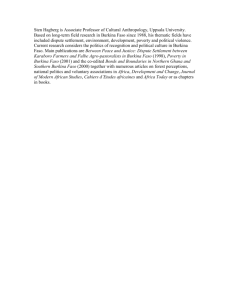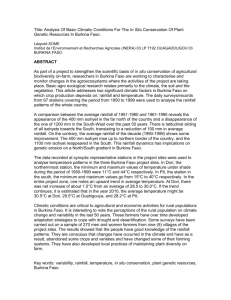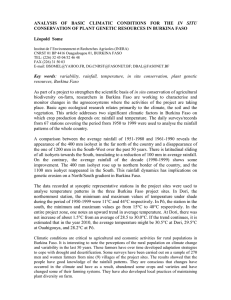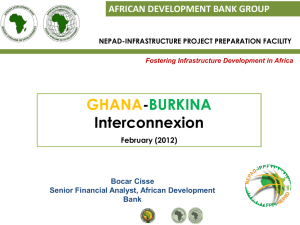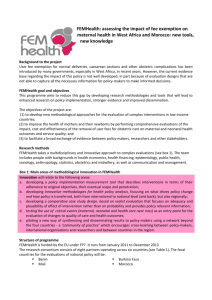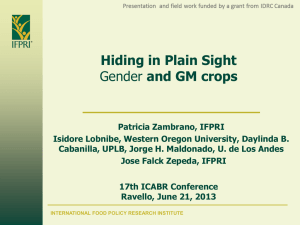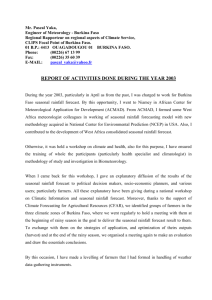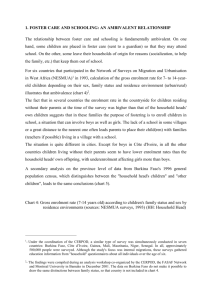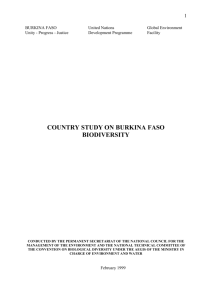RAINWATER HARVESTING TECHNIQUES IN BURKINA FASO
advertisement
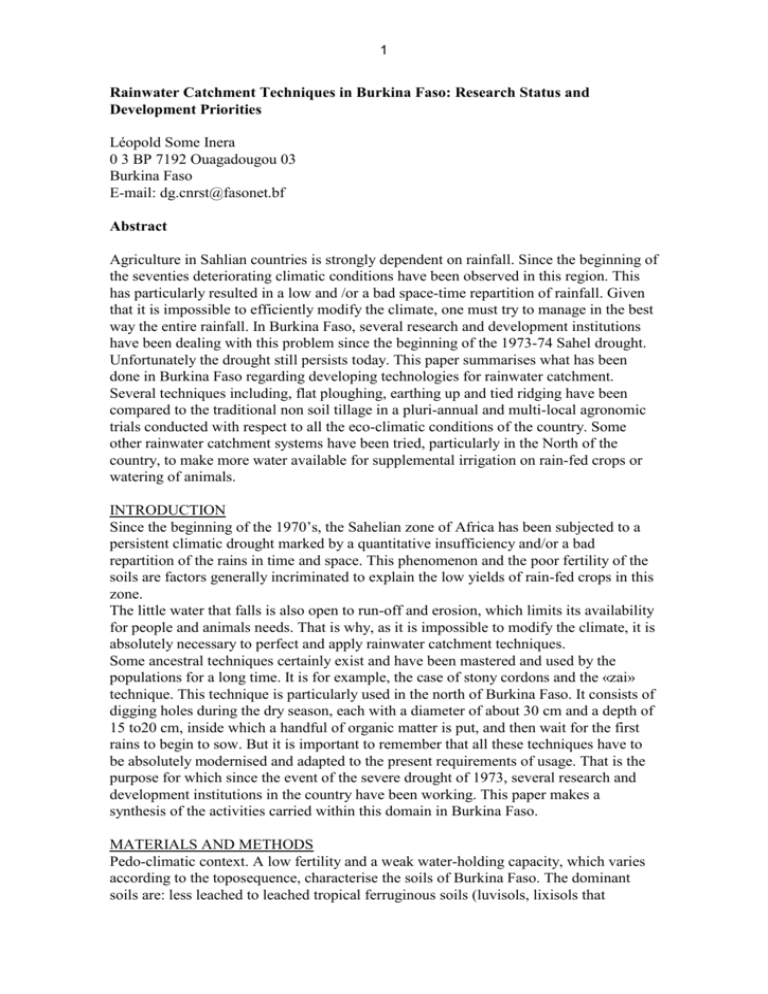
1 Rainwater Catchment Techniques in Burkina Faso: Research Status and Development Priorities Léopold Some Inera 0 3 BP 7192 Ouagadougou 03 Burkina Faso E-mail: dg.cnrst@fasonet.bf Abstract Agriculture in Sahlian countries is strongly dependent on rainfall. Since the beginning of the seventies deteriorating climatic conditions have been observed in this region. This has particularly resulted in a low and /or a bad space-time repartition of rainfall. Given that it is impossible to efficiently modify the climate, one must try to manage in the best way the entire rainfall. In Burkina Faso, several research and development institutions have been dealing with this problem since the beginning of the 1973-74 Sahel drought. Unfortunately the drought still persists today. This paper summarises what has been done in Burkina Faso regarding developing technologies for rainwater catchment. Several techniques including, flat ploughing, earthing up and tied ridging have been compared to the traditional non soil tillage in a pluri-annual and multi-local agronomic trials conducted with respect to all the eco-climatic conditions of the country. Some other rainwater catchment systems have been tried, particularly in the North of the country, to make more water available for supplemental irrigation on rain-fed crops or watering of animals. INTRODUCTION Since the beginning of the 1970’s, the Sahelian zone of Africa has been subjected to a persistent climatic drought marked by a quantitative insufficiency and/or a bad repartition of the rains in time and space. This phenomenon and the poor fertility of the soils are factors generally incriminated to explain the low yields of rain-fed crops in this zone. The little water that falls is also open to run-off and erosion, which limits its availability for people and animals needs. That is why, as it is impossible to modify the climate, it is absolutely necessary to perfect and apply rainwater catchment techniques. Some ancestral techniques certainly exist and have been mastered and used by the populations for a long time. It is for example, the case of stony cordons and the «zai» technique. This technique is particularly used in the north of Burkina Faso. It consists of digging holes during the dry season, each with a diameter of about 30 cm and a depth of 15 to20 cm, inside which a handful of organic matter is put, and then wait for the first rains to begin to sow. But it is important to remember that all these techniques have to be absolutely modernised and adapted to the present requirements of usage. That is the purpose for which since the event of the severe drought of 1973, several research and development institutions in the country have been working. This paper makes a synthesis of the activities carried within this domain in Burkina Faso. MATERIALS AND METHODS Pedo-climatic context. A low fertility and a weak water-holding capacity, which varies according to the toposequence, characterise the soils of Burkina Faso. The dominant soils are: less leached to leached tropical ferruginous soils (luvisols, lixisols that 2 represent 39% of all the soils), followed by erosion less leached soils on gravely materials (regosols) and alluvial supply (fluvisols)(BUNASOLS, 1985). The vegetation is mainly composed of mixed woody and herbaceous formations ranging from an Isoberlinia doka sparse forest in the south, to thorny shrubby steppe in the north through to a tree and shrubby savannah (Guinko, 1984). The climate is a SudanoSahelian type characterised by the altering of a dry season and a rainy season which duration varies between 3 and 6 months from the north to the southwest. The total rainfall volume collected per year also follows this spatial variation and goes from 300 mm in the Sahelian zone to 1.200 mm in the south-Sudanian zone (Some and Sivakumar, 1994). Because of this spatio-temporal variability, rain is the main climatic factor, which influence the inter-annual variation of the vegetation cover. The arithmetical changing means of the annual rainfall calculated in four synoptic stations with a 5 year slipping step show very well on figure 1, the progressive regression of this factor between 1950-1990 in the whole country. On the agronomic level it is better to take into consideration the frequency values of the rainfall rather than the average values. As an example, table 1 gives the recorded values in three rainfall stations. Such an erratic rainfall requires the use of rainwater collection and conservation techniques to ensure a sustainable agriculture and meet the needs of the population. Table 1: frequencial variability of the annual rainfall of 3 stations in Burkina Faso during the 1970-1990 period Probability Niangoloko(mm) Saria(mm) Gorom-Gorom(mm) 8years over 10 5 years over 10 2 years over 10 Mean of period 940.0 1042.7 1205.5 1070.8 686.5 719.6 929.8 742.7 262.7 340.1 408.3 328.3 Study network The management of the plots into stony cordons or into small clay dikes is generally done during the dry season. They consist as can be seen on figure 2, into alignments according to the boulder contour line or the confection of clay rolls of about 25 to 30 cm high. These methods are generally associated with tree, small shrub and Andropogon gayanus planting in order to improve the stability. Plot water saving techniques that have been tested in several locations of the country, are mainly composed of: -tied ridges -ploughing + earthing up -flat ploughing These techniques are associated or not with the stony lines. They are generally compared to directly sowing the soil as most of the farmers do. Figure 3 gives an illustration of a few crop plot water saving methods. Pluri-annual and multi-local trials have allowed us to study the impact of the techniques on the water balance and the yield of the main cereals crops grown in the country (sorghum, millet, and corn). Figure 4 shows the localisation of the agronomic trials sites that were defined according to the different pedo-climatic situations of the country (ICRISAT, 1981,1982; IITA/SAFGRAD, 1982; Nicou ET al., 1990). In 1993, a study was carried out by INERA on the effectiveness of the « zai » in the village of Nioniogo in the Central Plateau. On a naked glacis a device in Fischer blocks randomised with five treatments 3 and four replications was installed. The treatments were as follows: T1 absolute control - T2 pur fixed « zai » - T3 mobile « zai » - T4 fixed zai + mulching - T5 mulching only. Each elementary plot measured 16 m over 4 m. All the devices were demarcated by a surrounding wire to protect them against wandering animals and were situated downstream from the glacis. The glacis was divided into stony cordons by the farmers themselves. The techniques to stock water for the watering of animals or for crop irrigation use traditional micro-reservoirs. Figure 5 shows the diagram of the type of traditional microreservoir downstream a hardened complete naked dome. The reservoir dug upstream for the catchment of gullies have generally the form of reversed cones with a diameter of 60 m at the surface and 50 m at the bottom. The depth varies between 3 and 4 m. Downstream the reservoir at a distance of 10 to 20 m, is built a dike from 1 to 2.5 m high and whose walls consolidated with woody species, (Acacia senegal, Acacia nilotica or Prosopis juliflora) direct all the ravine water into the reservoir. Upstream the reservoir, situated at the largest point of the ravine, a 50 - 100 m long filtering dike is built. Rubble stones are placed in the middle, filtering all water that enters into the reservoir. The reservoir is built with a gradual slope, which allows the livestock to go down to drink water. Beyond 1-m depth, breeders fetch water for their animals. RESULTS AND DISCUSSIONS The plots management. The results of the impact of stony cordon spacing on runoff, infiltration and crop yields show significant differences. Some hydric profiles carried out at the end of the growing season (September 8th) have enabled us to better perceive the global impact of the different spacings of the stony cordons on the soil humidity. The results show that the nearer we are to the stony cordon, the more important the soil humidity is. The crop yields increase when we go nearer to the stony cordon. The yields also increase with the number of stony cordons. But it is important to point out that state extension services and NGOs working for rural development have not waited for experimental results to launch great operations of antierosive device realisation. On the whole, anti-erosive devices built from 1972 to 1995 by state institutions have covered 78,282 ha, that is to say, a mean of 3,404 ha every growing season (FEER, 1989; 1996). But in order to have a real impact, the anti-erosive management must cover the whole watershed rather than focusing only on the village fields, as is unfortunately so often the case. The traditional micro-reservoirs. The rural development services have not waited for the results of scientific research to extend to ravine catchment techniques or ponds overdigging either. NGOs such as the « Union Fraternelle des Croyants (UFC) » and development institutions such as the « Projet Agro-ecologique » and the « Programme Sahel Burkinabe » have done much in the realisation of small water reservoirs in the northern, mostly pastoral region of the country. It is in this way that the Programme Sahel Burkinabe has built between 1992 and 1995, 12 reservoirs all of which have a capacity of 5,000 m^3 to 15,000 m^3. A reservoir of 10,000 m^3 ensures the watering of a 3,000 UBT livestock without interruption between the two rainy seasons (1UBT equals a 250 Kg livestock). The experimental site installed by INERA in 1986 in Ziga and which allowed us to harvest about 300m^3 water downstream from an impluvium, is an example which 4 shows very well that the runoff water harvesting technique is a means to exploit in order to solve water problems. But what must also be reported is that the average cost of a reservoir in 1996 was of about $17,000 and local populations have not enough money. Plot water saving techniques. It is in this domain that since 1979, agronomic research has invested much effort in Burkina Faso. ICRISAT and IITA/SAFGRAD conducted the first experiments in 1979 at the Kamboinsin agricultural research station. They have since been followed by other research services. The studies on the soil surface management are conceived to determine the optimal dimension of a microcatchment basin in the case of tied rigges, the directions of use of the crop residues such as mulch and other cropping methods to retain water, increase infiltration and reduce run-off. The crop yields have been the main criteria to make the statistical assessment of impact of the techniques. Nevertheless other phenological characteristics of the plant have been measured and analysed to achieve a better interpretation of the data. The effects of water saving techniques on millet. As an example, the results presented on table 2 have been obtained for millet at Kamboinsin site in 1981. Table 2:The effect of water saving techniques on grain yield (kg/ha) and the weight of 1000 grains (grams) of millet varieties flat 1000 open 1000 tied 1000 tied ridges 1000 ploughing grains ridges grains ridges grains +mulching grains yield yield yield yield Local 137 6.73 121 7.67 362 9.70 650 10.3 Ex-bornu 237 4.83 293 5.63 1146 9.86 621 9.23 (Source:ICRISAT,1981) The tied ridges techniques improve significantly the weight of 1,000 grains and therefore its yield. The effects of water saving techniques on sorghum. Observations have been made on the sorghum rooting at several sites. An important difference is noticed between the treatments in the root front progression. At the beginning of S 10 sorghum variety height growth, the rooting front was respectively at 30 cm on the control, at 50 cm on the flat ploughing and at 45 cm on the tied ridges. Working the soil enables a better colonisation of the profile by the roots. Agronomic trials conducted at several sites during 1981-1986 period show that not working the soil leads to very low sorghum yields except for years which had particularly abundant rainfalls such as 1986 when 940 mm was recorded in Saria research station, that is to say 200 mm more than the mean (742.7 calculated between 1970 and 1990). Effects of water saving techniques on maize. The mean maize grain yield (14% humidity), obtained at 3 study sites shows a determinant effect of flat ploughing which provides a 50% yield increase in comparison to the control. On the other hand, no supplementary effect is seen with earthing + ridging particularly in regions with a satisfying rainfall such as Farako_Ba and Niangoloko. Effects of water saving techniques on cowpeas. The results obtained in 1983 on the two sites in the central part of the country, have retained our attention. They are presented in 5 table 3. Table 3:Effects of water saving techniques on the cowpeas grain yield in farmer’s field in 1983 (kg/ha) cropping method sites Oipassi Pabre control 390 415 flat ploughing 358 425 ploughing + earthing up 3 weeks after 527 702 sowing tied ridges 671 755 The statistical analysis carried out has shown significant differences between on the one hand, the treatments ploughing + earthing up and tied ridges and, on the other hand, flat ploughing plus the control that is the direct sowing without any working the soil. CONCLUSION. The different rainwater catchment methods which have been tested and extended here aimed to achieve the following objectives: i) retain and store the maximum of runoff water in the micro-reservoirs in order to water the animals during the dry season; ii) improve water infiltration and storage in the soil profile for the benefit of the crops; iii) slow down runoff and erosion at the watershed’s scale. Given the results, the techniques recommended by research and development institutions appear to be efficient. Their simplicity and their low cost make their realisation possible anywhere that they are needed. The plot water saving techniques have proved to be effective on all the crops. The earthing up effect is especially enhanced when it is preceded by flat ploughing. But the problem which remains is the bulky work that is required for the carrying out of these techniques. It would then be better to mechanise it in order to reduce its hardness. Besides, this point has been well perceived and defined among the research priorities in the framework of « Scientifique and Technological Research Strategic Plan « , adopted in 1995 by the Government of Burkina Faso. REFERENCES BUNASOLS,1985: Etat de connaissance de la fretilité des sols du Burkina Faso. Document technique n°1,47p.Ouagadougou,Burkina Faso FEER,1989: Table ronde des bailleurs de fonds du Programme quinquennal FEER. Exposé intrductif .30 novembre-1er décembre 1989 Ouagadougou, Burkina Faso. FEER,1996: Rappot sur les réalisations du FEER in « Les cahiers de la Présidence du Faso n°16 du 3 décembre 1996:p.17 Ouagadougou, Burkina Faso. Guinko,1984: Végétation de la Haute-Volta. Thèse Doctorat es-sciences, Université de BordeauxIII Tome 1 et2 ,394p. ICRISAT, 1982: Résumé du Rapport Annuel Programme coopératif ICRISAT, HauteVolta. IITA/SAFGRAD,1982: Rapport annuel Programme d’agronomie du maïs Ouagadougou Haute-Volta. IITA/SAFGRAD,1986: Final report, phase I Ouagadougou,Burkina Faso. Nicou, R.,Outtara, B., Some, L. : Effets des techniques d’économie de l’eau à la parcelle sur les cultures céréalières (sorgho,maïs,mil) au Burkina Faso. L’Agro.Trop. 45-1:43-57 Programme Sahel Burkinabe,1996 : Bilan d’activités 1990/1996 Projet 6 deDéveloppement Intégré de la province du Séno.(UNSO/BK/90/X01) Dori- Burkina Faso.
